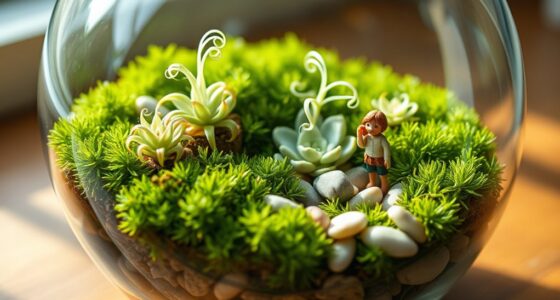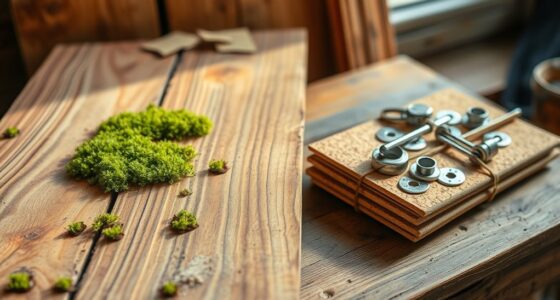To declutter your home effectively, start by setting clear goals and gathering storage solutions. Sort your items into categories, deciding what to donate, discard, or keep, especially handling sentimental possessions with care. Organize what’s left for easy access using space-efficient solutions, then establish routines to maintain your tidy space. Staying consistent and mindful of emotional attachments will help you create a more organized, clutter-free environment. Keep going to discover more tips for lasting results.
Key Takeaways
- Set clear goals and create a manageable plan to organize your decluttering process.
- Sort items into categories, handling sentimental belongings with care and setting aside donations.
- Use labeled bins and designated drop-off points for efficient discarding and donating.
- Arrange remaining items logically with space-saving solutions for easy access and maintenance.
- Establish routines and regularly reassess storage to sustain a clutter-free environment.
Preparing for Your Decluttering Journey

Have you thought about how to start your decluttering process? The first step is planning ahead. Think about your goals and how much time you can dedicate. Gather some effective storage solutions like bins, shelves, or baskets to keep things organized. Be mindful of emotional attachments; items with sentimental value can be tough to part with. Prepare yourself mentally by acknowledging that decluttering is about creating space for what truly matters. Set realistic expectations and break the process into manageable sections. Having a clear plan reduces overwhelm and keeps you motivated. Remember, this isn’t just about tidying up—it’s about creating a home environment that supports your well-being and lifestyle. Proper preparation is key to a successful decluttering journey. Additionally, understanding industry transformations such as AI automation can help you adopt new organizational tools that make decluttering more efficient.
Sorting and Categorizing Your Items

Once you’ve planned your decluttering approach, the next step is sorting and categorizing your items. Begin by grouping similar items together, such as clothing, books, or kitchenware. As you sort clothing, set aside pieces suitable for clothing donations—those in good condition but no longer needed. Handle sentimental items carefully; keep only those that truly hold emotional value and consider donating or discarding the rest. Use boxes or bins to separate categories, making it easier to see what you have. Be honest with yourself about what you really need or love. This process helps you visualize your possessions clearly, reducing clutter and preparing you for the next phase of decluttering. Proper sorting guarantees you make informed decisions about what stays and what goes, and incorporating vertical storage solutions can optimize your space even further.
Creating a System for Discarding and Donating
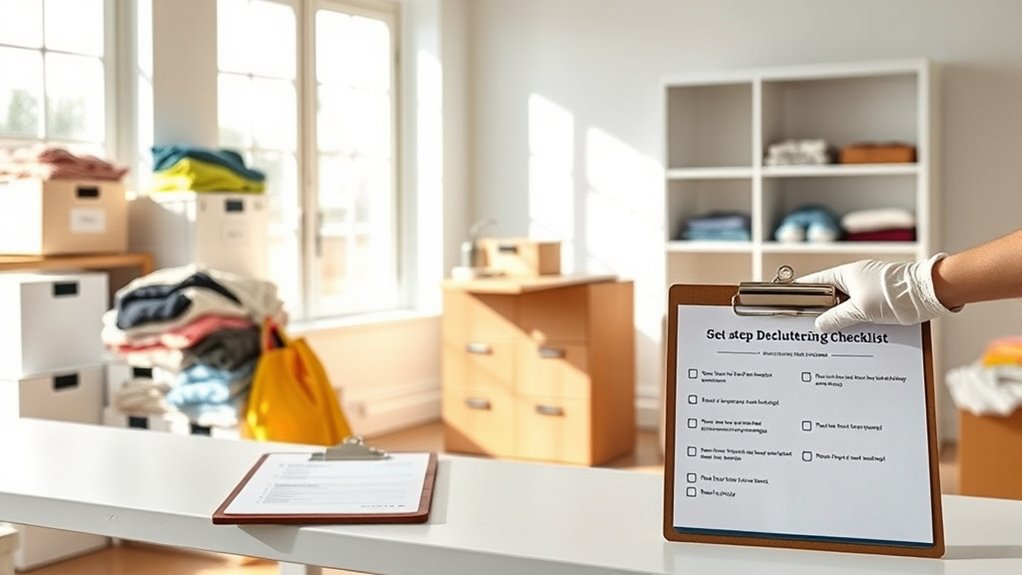
Creating a system for discarding and donating guarantees your decluttering efforts are sustainable and effective. Start by designating specific donation centers where you’ll drop off items you no longer need, making it easy to follow through. Set a schedule for regular drop-offs to prevent piles from building up. For items unsuitable for donation, explore recycling options to ensure they’re disposed of responsibly. Keep separate bins or boxes labeled for donation and recycling to streamline the process. Be honest about what you truly need to keep, and establish clear criteria for discarding items. This organized approach minimizes clutter buildup and keeps your space manageable. Additionally, understanding the emotional significance of certain items can help you make more mindful decisions during decluttering. With a consistent system, decluttering becomes simpler, helping you maintain a clutter-free home in the long run.
Organizing Remaining Items for Maximum Efficiency
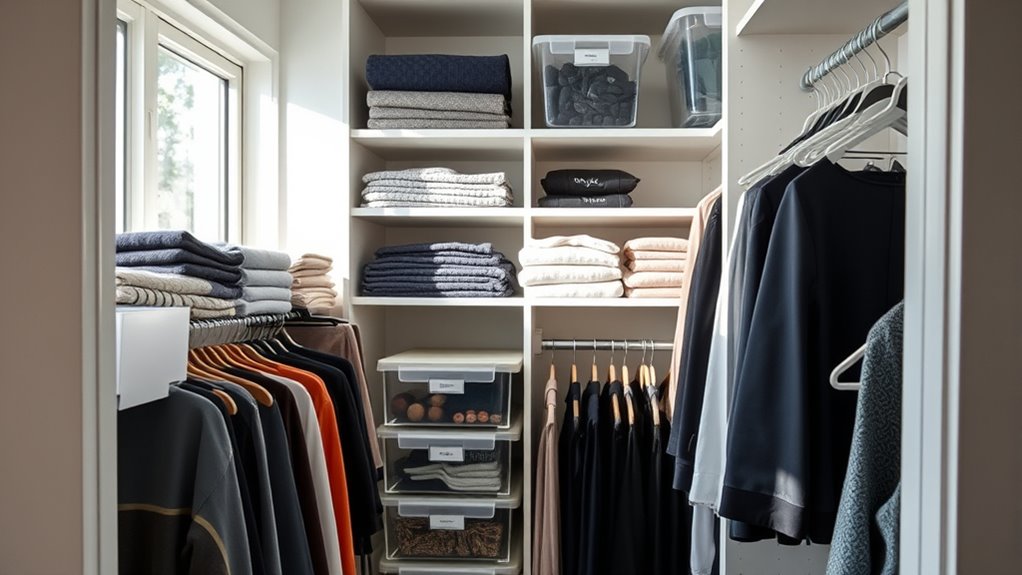
To maximize efficiency, focus on arranging your remaining items thoughtfully so they’re easily accessible and logically grouped. Use smart storage solutions that suit each item’s size and frequency of use. Prioritize space optimization by utilizing vertical storage, drawers, and clear containers. Group similar items together, such as kitchen utensils or office supplies, for quick retrieval. This organization reduces clutter and saves time. Consider this table to guide your setup:
| Item Type | Ideal Storage Solution |
|---|---|
| Frequently Used | Easy-to-reach shelves |
| Rarely Used | Overhead or underused space |
| Small Items | Clear containers or bins |
| Large Items | Spacious cabinets or closets |
Implementing these strategies ensures your space remains functional and organized, and regularly reassess your storage solutions to maintain effective organization.
Maintaining a Clutter-Free Environment
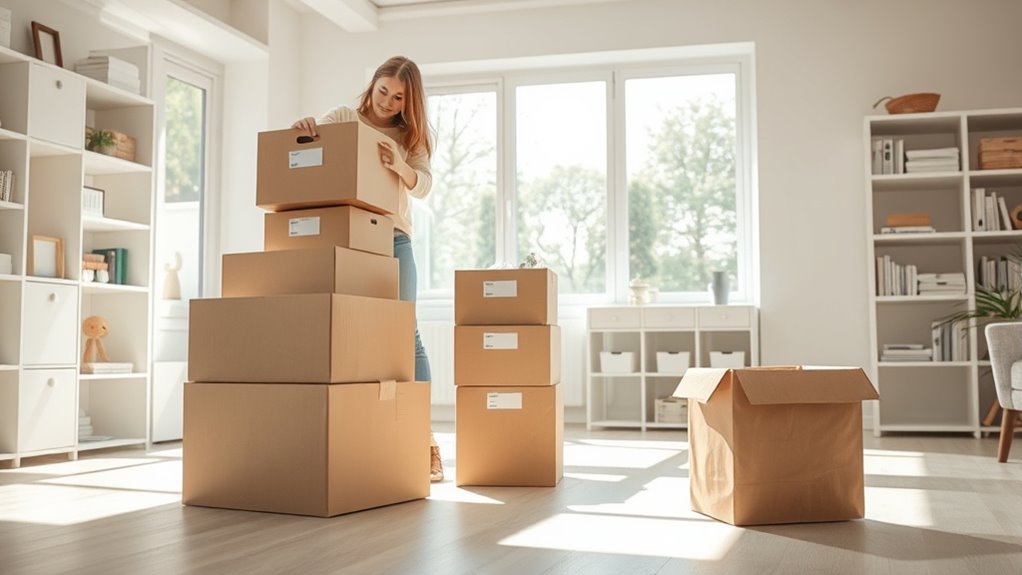
Maintaining a clutter-free environment requires consistent effort and intentional habits. You should regularly reassess your storage solutions to guarantee they’re effective and accessible, preventing clutter from piling up. Develop routines, like daily tidying or weekly reviews, to keep things organized. Be mindful of emotional attachment to items—ask yourself if an item truly adds value or joy. If it doesn’t, consider donating or recycling it to free up space. Avoid letting sentimental feelings keep clutter in your home; instead, create designated areas for keepsakes. Making these habits automatic helps sustain your decluttered space over time. Additionally, incorporating organizational strategies can further streamline your space and maintain order. Remember, a clean environment isn’t a one-time achievement but an ongoing process that supports tranquility and efficiency in your daily life.
Frequently Asked Questions
How Long Does a Typical Decluttering Process Take?
The timing expectations for decluttering vary based on your space and how much clutter you have. Generally, it can take anywhere from a few hours to several weekends. The process involves different decluttering phases, like sorting, organizing, and discarding. You can speed up or slow down depending on your pace. Stay consistent, and you’ll see progress, but don’t rush—it’s about creating a more organized home.
What Are Some Eco-Friendly Disposal Options?
When you’re looking for eco-friendly disposal options, consider participating in recycling programs for plastics, paper, and electronics. You can also donate usable items to donation centers, reducing waste and helping others. Remember to research local recycling initiatives and donation centers in your area, as they often accept different types of items. This way, you keep your clutter out of landfills and support sustainable practices.
How Can I Motivate Myself to Start?
To motivate yourself to start decluttering, try using motivational techniques like visualizing the benefits of an organized space. Set clear, achievable goals with specific deadline-driven strategies, which help you stay focused. Break the task into smaller steps to avoid feeling overwhelmed. Reward yourself after completing each part. Remember, maintaining a positive mindset boosts your momentum, making it easier to begin and keep going.
What Tools or Supplies Are Essential?
You might think you need fancy tools, but essential supplies like storage bins and cleaning supplies are all you really need. Don’t underestimate the power of simple storage bins—they keep your space organized and make sorting easier. Cleaning supplies help you tackle dust and dirt as you declutter, making the process smoother. With these basics, you’re well-equipped to start decluttering confidently, transforming your space step by step.
How Do I Handle Sentimental Items?
When organizing sentimental items, you want to handle each piece carefully and thoughtfully. Preserve sentimental items by choosing appropriate storage like acid-free boxes or frames to prevent damage. Decide what truly matters to keep, and consider digitalizing photos or mementos to reduce clutter. Take your time, and don’t rush the process. Handling sentimental items with care helps you preserve their emotional value while creating a more organized, clutter-free space.
Conclusion
By following these steps, you’ll transform your home into a clutter-free paradise faster than you can say “organized chaos.” Imagine your space so pristine, even a tornado wouldn’t dare leave a mess behind! Decluttering isn’t just cleaning; it’s releasing your inner superhero, conquering chaos with ease. Stick to the plan, stay consistent, and watch your home become a sanctuary so perfectly tidy, it’ll make everything else in life feel like a breeze.




